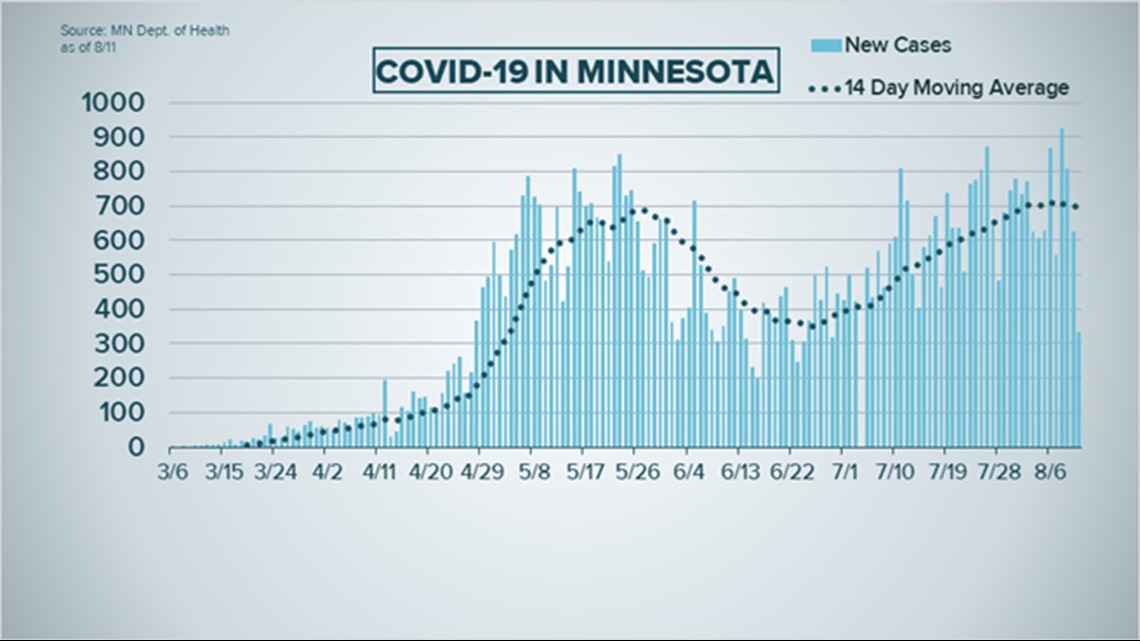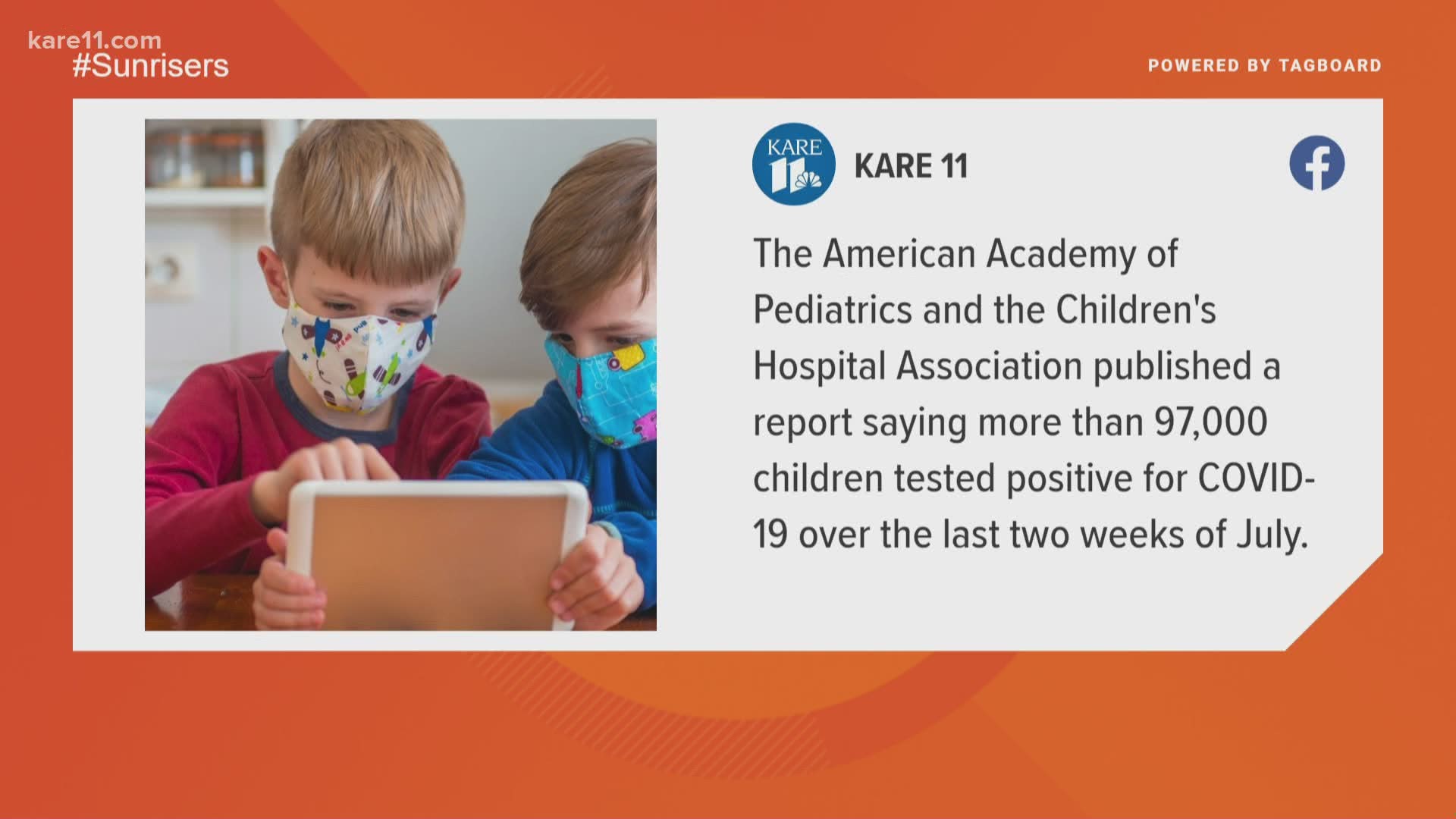ST PAUL, Minn. — Tuesday, Aug. 11
- MDH reports 12th consecutive day with hospitalizations at 300 or more
- Visitor restrictions to loosen on long-term care facilities
- COVID makes for quiet, socially distanced move-in day at SCSU
11 a.m.
COVID-19 hospitalizations remain at a higher number than officials at the Minnesota Department of Health would like to see, with a 12th straight day of 300 or more.
Currently 337 people are being treated in hospitals across the state for complications of the coronavirus, with 147 of those cases serious enough to require treatment in the ICU.
MDH is reporting 332 new cases of COVID-19 confirmed in the past 24-hour reporting period, bringing the total since the onset of the pandemic to 61,839. The number of new cases is significantly lower than in recent days, but is based on just 6,302 tests completed in private and state labs.
Six more Minnesotans have died of complications from the virus, bringing the total of fatalities in the state to 1,666. Of those deaths, 1,251, or 75% of them, have occurred in long-term or assisted living facilities. On Monday state health officials talked about new guidance that will allow long-term care facilities to loosen their visitor policies starting Aug. 29, based on a number of criteria to ensure safety.
MDH says 55,151 people who at one time tested positive for the coronavirus have recovered to the point they no longer require isolation.
People between the age of 20 and 29 continue to be a source of concern for health officials, making up the state's largest group of COVID-19 cases with 14,447. Four people in that age bracket have died. Those between 30 and 39 account for 11,332 cases and 14 deaths, while people from 80 to 89 years old comprise just 1,995 cases but 559 deaths. The next-closest age group is people between 90 and 99, with 422 fatalities.
Hennepin County accounts for 19,569 of the state's cases, and 839 of the total deaths. Ramsey County reports 7,717 cases and 268 deaths, while Dakota County officials 4,507 cases and 106 deaths.




Monday, Aug. 10
2 p.m.
On a Monday afternoon briefing call, state health officials gave more details about upcoming relaxed visitation policies in long-term care facilities.
According to the Minnesota Department of Health (MDH), new guidance will take effect Aug. 29 allowing facilities to decide on the most "appropriate" visitation policy for their residents and staff.
MDH cited a desire to balance COVID-19 prevention with the well-being of residents who have been isolated during the pandemic. The health department also said visits help identify maltreatment and abuse. Maltreatment reports have gone down by 20% compared to a similar period from 2019.
MDH Commissioner Jan Malcolm said Monday that over 90% of assisted living facilities in the state have had zero COVID-19 cases in the last 28 days. Just over half of skilled nursing facilities have ever had an outbreak, Malcolm said, and just under 30% have had a case in the last 28 days.
Malcolm said MDH shares these statistics to remind the public that long-term care facilities have worked hard to mitigate outbreaks and have made progress reducing the number of cases in their communities.
The pandemic is into its eighth month with unfortunately no indications of slowing down, Malcolm said, making the need to balance safety with the well-being of residents an "urgent priority."
"We need to be finding solutions that are sustainable over the long-term," said Lindsey Krueger, director of the MDH Office of Health Facility Complaints. "Walling of residents from the majority of their family and friends is simply not a sustainable approach, but neither is allowing wide open visitation."
Krueger said they are asking for each facility to assess their own risk based on MDH guidance. Nursing home residents are four times as likely to contract COVID-19 as assisted living-type facility residents, Krueger said.
Krueger listed three reasons MDH has decided to roll out these new guidelines now, with the pandemic showing no signs of letting up.
- MDH has a robust system in place including testing, procedures to request personal protective equipement (PPE), and crisis staffing support with more than 1,100 qualified health care professionals signed up in the database.
- The vast majority of long-term care facilities are in good shape and many would meet the stringent criteria set in place.
- MDH does not believe the current restrictions are sustainable. "We have had stringent visitor restrictions in place for months, and that kind of blunt tool cannot be left in place forever without real costs," Krueger said.
Minnesota Deputy Ombudsman for Long-Term Care Aisha Elmquist said the isolation is a concern for her office, as well.
"Our office sees daily examples of the suffering and desperation this causes," she said.
Elmquist said many people who contact her office are in a situation like this: "They are alone in a room, or perhaps a small apartment, almost all day every day. They leave their long-term care setting only for essential medical appointments, if at all."
Many are experiencing emotional or mental deterioration due to the restrictions on visitors, Elmquist said.
"We hope this guidance will help to alleviate the solitude and heartache that people in long-term care have endured over the past months," she said.
Melanie Van Wyhe, a Stillwater woman whose mother is in long-term care, spoke on the briefing call as well. She told her story of watching her mother deteriorate as she was unable to have visitors, during one conversation asking Melanie if she was in prison.
"If you have a loved one in a facility, I encourage you to not give up," Van Wyhe said. "Staff can be great, but they aren't family."
Malcolm said MDH is not requiring any facilities to allow visitors, but is offering guidance should facilities choose to move forward with lifting some restrictions.
Krueger said facilities don't need to send plans to MDH, they just need to use the guidance to determine whether they are in a stable enough place to allow visitors.
Elmquist said that participation in the essential caregiver program, which was introduced to facilities a month ago as one avenue to allow friends and family back in for visits in a designated role, has been "spotty."
"There have been a number of facilities that have declined to begin an essential caregiver program at this time," she said.
Elmquist said that they are aware of the risks associated with rising COVID-19 cases in the state, but that loneliness and isolation are health risks, too.
"We simply can't keep loved ones in isolation with no end in sight," Elmquist said.
11 a.m.
Numbers issued Monday by the Minnesota Department of Health (MDH) indicate 320 people are being treated for COVID-19 in hospitals across the state, continuing a trend that has officials concerned.
Of those 320 patients, 159 are showing symptoms serious enough to require treatment in the ICU. Monday marks the 11th consecutive day that 300 or more people have been hospitalized, after a stretch where that number was down below the mid-200s.
MDH says an additional 625 people tested positive for the coronavirus in the past 24-hour reporting period, bringing the total number of cases to 61,516 since the pandemic started. Those new cases were based on the results of 12,787 cases processed in private and state labs in the past day.
Three more Minnesotans have died of COVID-19, bringing the total of fatalities to 1,660.
Health officials say 54,364 people who at one time tested positive for the virus have recovered to the point they no longer require isolation.
Those between the ages of 20 and 29 continue to make up the largest group of cases in the state with 14,377. Four people from that age group have died. People from 30 to 39 account for 11,275 of the cases and 14 deaths, while those from 80 to 89 make up just 1,984 of the cases but 556 of Minnesota's deaths. That's 33% of the state total.
Hennepin County has the most COVID cases, reporting 19,472 with 835 deaths, more than half of the state's total fatalities. Ramsey County reports 7,658 cases and 267 deaths, while Dakota County has registered 4,480 cases and and 106 deaths.
KARE 11’s coverage of the coronavirus is rooted in Facts, not Fear. Visit kare11.com/coronavirus for comprehensive coverage, find out what you need to know about the Midwest specifically, learn more about the symptoms, and see what businesses are open as the state slowly lifts restrictions. Have a question? Text it to us at 763-797-7215. And get the latest coronavirus updates sent right to your inbox every morning. Subscribe to the KARE 11 Sunrise newsletter here. Help local families in need: www.kare11.com/give11.
The state of Minnesota has set up a data portal online at mn.gov/covid19.

